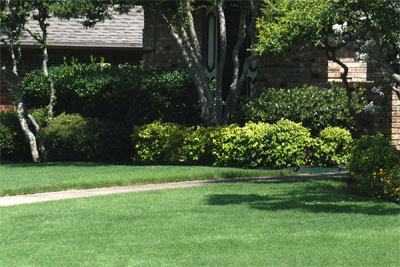Tips for Terrific Turf

Lawn Care Tips – Don’t ‘Start Over’ Just Yet
"Neil! My lawn is so bad, I just want to start over." It’s a question/comment I hear a hundred times each year. That’s a lot of hard work, and I’ll try to save you much or most of it. We’ll outline steps to a perfect lawn within just a few months – starting now.
Lawn Tip 1: Is the grade of the lawn the way that you want it? In other words, does it puddle, or is it rough when you mow? Those would be two of the main reasons to start over with new turf plantings. If the lawn is just weak and full of weeds, don’t rush for the tiller.
Lawn Tip 2: In the unlikely event that you DO need to start over to plant new grass, begin by spraying with a glyphosate-ONLY herbicide. It will kill existing vegetation without contaminating the soil. Allow it 10-15 days to do its job, then rototill to 3-5 inches with rear-tine tiller, and rake to a smooth grade. But, I’m trying to talk you out of all that.
Lawn Tip 3: At some point, consider whether you have the proper grass at all. We’ll spend our next few tips outlining the positves and negatives for each common candidate for Texas turfgrasses. Choose wisely. It’s a major and long-term decision.
Lawn Tip 4: Common bermudagrass is the most popular choice in North Texas. It’s inexpensive, durable, vigorous, cold-hardy and resistant to most weedkillers you might want to use with it. On the other hand, it’s really invasive into beds, and it’s intolerant of shade (needs 6 or more hours of direct sunlight). Most likely grass to cause allergies.
Lawn Tip 5: St. Augustine is the dominant grass. (Crowds out all others, including bermuda.) It is more tolerant of shade (as few as 4 hours of direct sunlight). Easily eliminated should it invade beds. However, it’s intolerant of traffic, and it can be hurt by extreme winter cold (low single digits). Raleigh good in N. Tx., Floratam in S. Tx.
Lawn Tip 6: Zoysia varieties are intermediate to bermuda and St. Augustine in texture, height, shade tolerance, etc. BUY IT LOCALLY. Do not buy plugs by mail. Slow to cover, so solid-sodding is best bet. Ask to see examples before you buy. Nice developments in new zoysias are being made, but it’s still not a mainstream grass in most of Tx.
Lawn Tip 7: Buffalograss (varieties ‘Prairie’ and ‘609’) were touted as being drought-tolerant (actually, about equal to bermuda in lawn uses). Intolerant of shade, but biggest threat is that you cannot keep neighboring bermuda from invading and overtaking it. Personal opinion: not a good option in most urban areas.
Lawn Tip 8: Fescues are common in the Texas Panhandle and southeastward by a few counties. Not well suited to hot, humid areas. Centipede is common in East Texas’ sandy soils, where it is a suitable, low-maintenance option. Resembles St. Augustine in appearance.
These first 8 of our Lawn Tips aimed at giving you a great lawn by mid-summer have dealt with grass options. My goal will be that you NOT have to start over by tilling and planting new grass. The following tips are aimed at resurrecting existing turf until it’s rich, dense and vigorous.
Lawn Tip 9: To get poor turf to thicken up and look better, there are three main responsibilities. (1) Mow at recommended height. (2) Fertilize according to need. (3) Water responsibly. Do those, and your grass should thrive – that’s assuming you’ve chosen the right type, as outlined in earlier tips. Details will follow in the next three tips.
Lawn Tip 10: Mow at recommended height. Common bermuda: 1.25 – 1.5 inches. St. Augustine 2 – 2.5 inches. Hybrid bermudas .25 – .75 inch. Zoysia 2 – 3 inches, depending on variety. Buffalograss 3-4 inches. Fescue 3 inches. Remember: grasses with runners will be thicker and more vigorous if kept low. Tall grass becomes weak grass.
Lawn Tip 11: Fertilize according to need. Common bermuda and zoysias every two months, late Mar. or early Apr. through early Oct. St. Augustine late Mar./early Apr., early June and early Sept. Hybrid bermudas every 6-7 weeks, but with lighter amounts. Buffalograss mid-May, mid-Sept. Fescue Sept., Nov., Feb. Type of fertilizer in next tip.
Lawn Tip 12: Have your lawn soil tested every few years to monitor needs. Normally, clay soils will need all-nitrogen fertilizer, while sandy soils will need high-nitrogen (4-1-2 ratio). Buy a quality fertilizer where half or more of the nitrogen is in slow-release form. Neil Sperry’s Texas Best Fertilizers are such, but there are other good brands.
Lawn Tip 13: Water is a precious commodity in Texas. Conserve it as best you can. Have a "smart" controller installed. They monitor many factors to determine when sprinklers need to run. Otherwise, don’t water on preset intervals – wait for grass to show signs of drying before you water, then soak soil deeply – preferably in early morning.
Lawn Tip 14: Weed control begins with answering three pairs of questions. (1) Is the weed annual or perennial? (2) Does the weed grow more actively in cool weather of winter and spring, or is it a hot-weather weed? (3) Is it a grassy weed (slender leaves with parallel veins, chaffy flowers), or is it non-grassy ("broadleafed")?
Lawn Tip 15: Annual weeds can be controlled BEFORE their seeds germinate by use of a PRE-emergent weedkiller (usually granules). These only affect sprouting seeds, not the permanent lawn, and not the trees and shrubs. Typical timing would be early Sept. for winter weeds and, for summer weeds, early March, repeated early June.
Lawn Tip 16: Perennial weeds will not be helped much by pre-emergent herbicides. Use broadleafed weedillers (containing 2,4-D) for the non-grassy types like dandelions and clover. You’ll have to spot-treat for grassy types, as we no longer have products that will selectively kill weed grasses without harming the lawn.
Lawn Tip 17: Nutsedge ("nutgrass") is a weed to itself. It isn’t a true grass, but indeed a sedge (triangular stems, where grasses are round). Best control is with Image or Sedgehammer. They work differently from other herbicides, so read and follow label directions carefully.
Lawn Tip 18: Give your lawn good and regular care, and you should have few weed problems. Don’t be afraid to try registered and properly labeled herbicides according to their directions. They can be a big help in reducing your weed populations to manageable levels.

